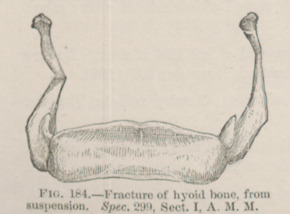Title: W——, H.
Source text: Surgeon General Joseph K. Barnes, United States Army, The Medical and Surgical History of the War of the Rebellion. (1861–65.), Part 1, Volume 2 (Washington, D.C.: Government Printing Office, 1870), 400.
Civil War Washington ID: med.d1e18323
TEI/XML: med.d1e18323.xml
CASE.—H. W——, jailor, was hanged at Washington, November 10th, 1865. He was about 40 years of age, and weighed about 160 pounds. The rope was half an inch in diameter; the knot was placed under the left ear; the fall was five feet. The body was suspended for fifteen minutes and then removed to the hospital. No rigor, no relaxation of sphincters, no seminal ejaculation. Face pallid; eyes not congested, pupils dilated; mouth open, but tongue not protruding. Cicatrices on left shoulder, forearm, and legs, of old ulcers, probably scorbutic. A deep sulcus, with tumefaction of the adjacent soft parts. Laceration of the inner fibres of the trapezius and of the belly of the sterno-mastoid was observed on removing the skin. The hyoid bone had received six injuries separation of the greater and lesser processes on both sides from the body of the bone and true fracture of the outer third of the greater process on either side. There was no lesion of the brain. The atlas and axis had not been luxated, and the spinal cord had escaped compression. In the thorax, old pleuritic adhesions; aortic insufficiency, with calcareous deposits; in the abdomen, nothing abnormal. On the right forearm were cicatrices and two small indolent ulcers, involving the integuments only. The bones of the forearm had not been fractured or resected. Drs. W. Thomson and H. Allen, from whose official report the foregoing notes are taken, remark the extreme rarity of fractures of the hyoid. Death resulted from apnœa alone. The specimens forwarded with the report are Nos. 293 to 302, inclusive, in the Surgical Section. The preparation of the hyoid is represented in the wood-cut (FIG. 184).
